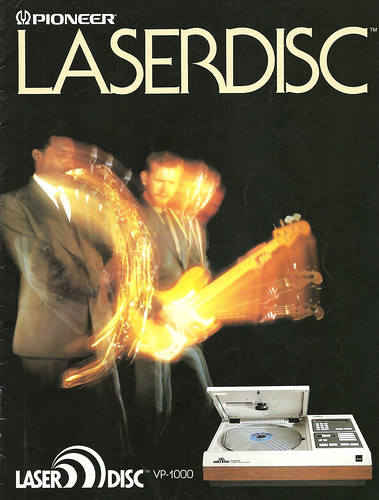
The VP-1000 was the first laser optical videodisc player to be sold under the Pioneer name and the second consumer player
available in the USA. Co-designed by Pioneer Electronics and MCA DiscoVision technicians as part of the Universal Pioneer
partnership, the VP-1000 was, in most respects, a consumer version of DiscoVision's industrial PR-7820. While first shown
in May, 1980 the VP-1000 didn't go on sale until just before Christmas of that same year and incorporated both features, performance
and reliability that made the Magnavox Magnavision 8000 player seem hopelessly antiquated - for the amazingly low price of
$749. An optional $50 wireless remote was offered (it could also operate as a wired remote), but the VP-1000 duplicated every
function on the top panel of the player itself. In terms of performance, the VP-1000 benefited extensively from the MCA DiscoVision
technicians knowledge of their disc pressing difficulties and the defects a disc might have and Pioneer's skill gained in
building the PR-7820 for DiscoVision. Thus, picture quality and disc tracking ability were excellent - the VP-1000 offered
the full 330 lines of resolution that broadcast NTSC was capable of (including full I/Q chroma bandwidth) and unlike the Magnavox
8000, the VP-1000 didn't send out the 3.58 MHz color burst signal during playback of black and white discs, which would cause
a red and blue 'confetti-like' interference in the picture due to the televisions color circuits being needlessly activated.
In addition, the VP-1000 would properly track almost any disc played on it without skipping or laser-lock. With a CLV Extended
Play disc that was warped or imperfectly pressed, crosstalk during playback could be quite visible (tilt-servo's were not
incorporated into LV players yet and the CAA Extended Play format didn't appear until 1983) but compared to the Magnavox 8000,
which would often start to skip before any crosstalk could be seen on a warped disc, the VP-1000 was a revelation.
The VP-1000 did have some growing pains though, leading to an upgraded player known as the VP-1000A. With the original VP-1000,
some CLV discs simply wouldn't begin to play, even though they had played perfectly on the same player before. The VP-1000's
power supply could also suddenly overheat and burn out. The VP-1000A corrected these problems and for existing VP-1000 owners,
Pioneer would upgrade their player to the "A" status for free, even if it was out of warranty. In addition, Pioneer and MCA
DiscoVision designed an improved circuit for demodulating the FM audio, which greatly increased the players sound quality
(especially when the outboard CX noise reduction unit was used with CX encoded discs), and the old audio board was swapped
for the new one as part of the upgrade. The new audio board gave the VP-1000A the best analog sound of any LD player made;
even the $3000+ players didn't have as good analog audio as the VP-1000A. By mid-1981, all VP-1000's were the upgraded "A"
version. Pioneer even recalled units from dealer stock to do the upgrade and those players can be identified by a red "A"
stamped next to the player model number printed on the side of the box.
The VP-1000 has a 75 ohm coax "Adapter" output on its back panel which was to be used for 14-bit PCM audio discs that were
expected to become available. At the time the VP-1000 was designed it was thought by most in the industry that all videodisc
players should also have the capability to do double-duty and play digital PCM audio discs via the addition of a low-cost
PCM adapter. The Philips/Sony Compact Disc was still on the drawing board and the thinking was that PCM audio would require
several MHz of bandwidth that the videodisc could easily handle. Thus, the adapter output for PCM discs. On the VP-1000 the
adapter output signal is just the demodulated video signal without blanking or drop-out compensation applied and no on-screen
displays of frame, time or chapters overlaying the image - since the PCM sound was to be encoded as a black and white image,
these would block data, leading to errors in decoding. Contrary to speculation, the adapter jack is NOT a raw output of the
disc's RF spectrum and thus compatible with Dolby AC-3 demodulators and discs that have AC-3 digital data in place of the
right analog FM carrier at 2.8 MHz.
By the time the 'economical' LD-660 was available, you could buy a brand new VP-1000 on close-out for less than $300. So,
why buy the crippled LD-660 when you could have a full-featured player (with identical video performance and better sound
quality) for less than half the cost
|

